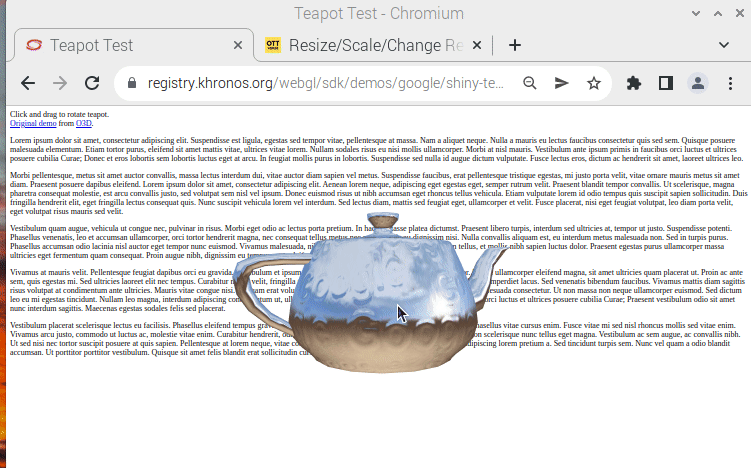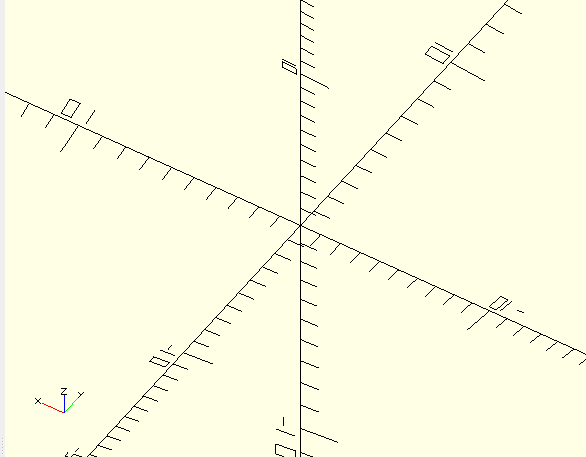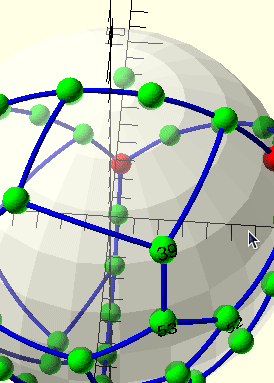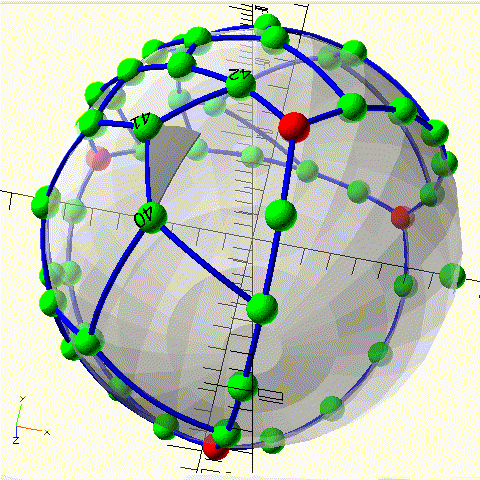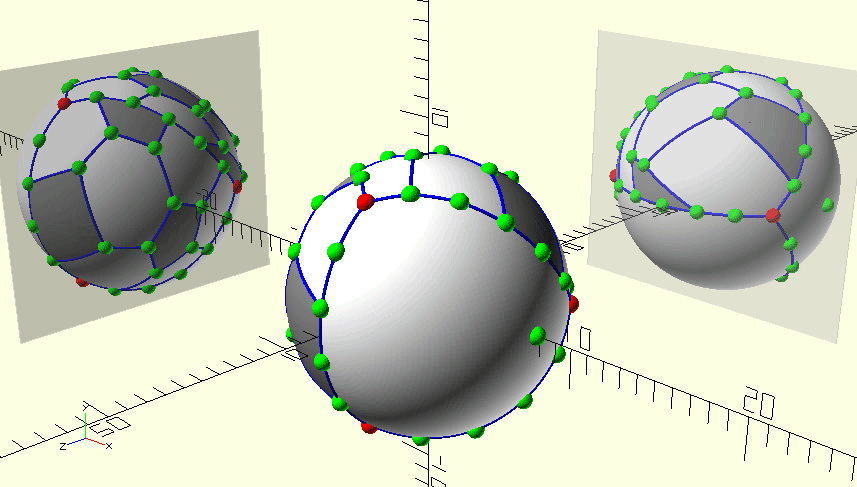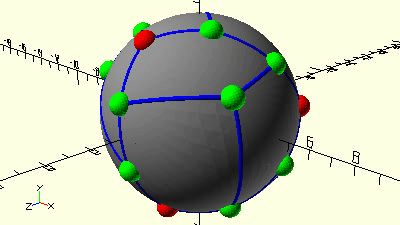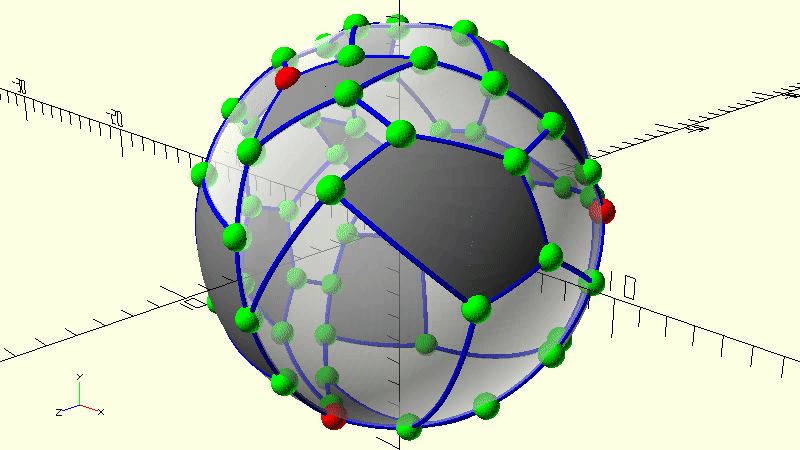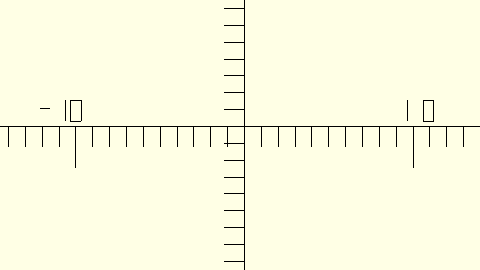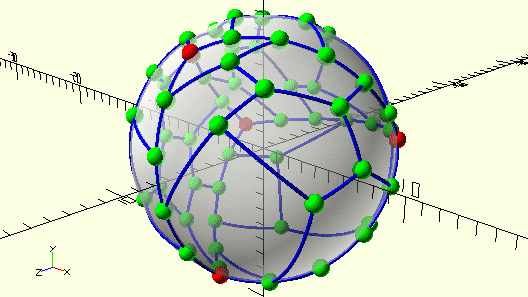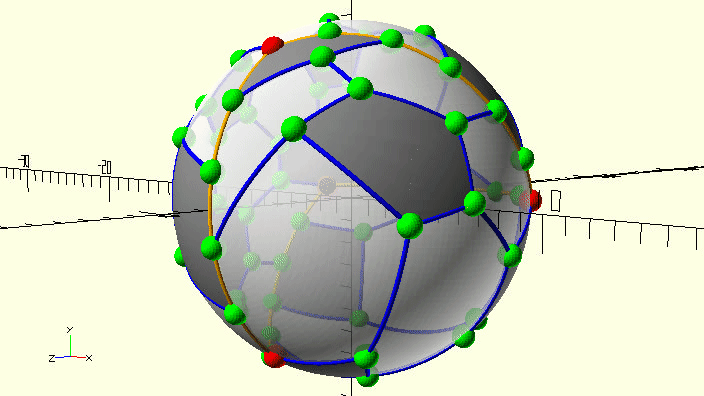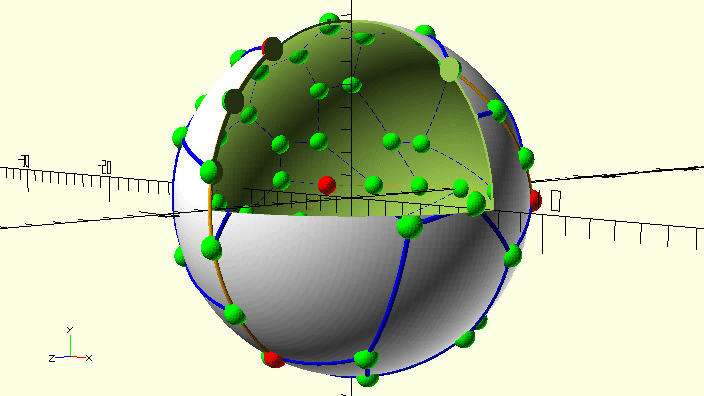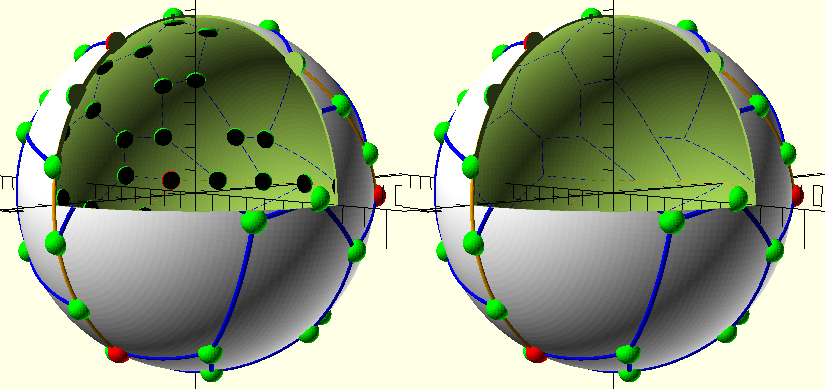In case somebody wants to look into this round edge issue, code is not good enough to commit+push yet.
New tuttte.js has been committed and pushed before, current "node.tetra.js" dump at bottom of this posting.
Function "srad2deg()" converts the JavaScript spherical [phi,theta] coordinate in radians to degree for OpenSCAD:
This is central edge drawing function, painting "edge()" and "edge2()" as blue ("sele" is number of edge to draw blue):
Here dump of "node.tetra.js" as is — any help in diagnosing how "edge2()" needs to be modified to be correct is appreciated:
Code: Select all
// Copyright: https://mit-license.org/
#include "assert.js"
#include "util.js"
#include "gauss-jordan.js"
#include "tutte.js"
#include "undirected_graph.js"
var coords;
var coords2;
var fs = require("fs");
var writer;
var white = (process.argv.length > 3);
var sele = (process.argv.length > 4) ? parseInt(process.argv[4]) : 0;
var V = 0;
var i;
function out(x) {
return (typeof(x) === 'object') ? JSON.stringify(x) : x;
}
function wlog(...s) {
writer.write(out(s[0]));
for(var i=1; i<s.length; ++i) {
writer.write(" " + out(s[i]));
}
writer.write("\n");
}
function rad2deg(r) {
return r / Math.PI * 180;
}
function srad2deg(p) {
return [rad2deg(p[0]), rad2deg(p[1])];
}
function scale_3D(v, f) {
return [f * v[0], f * v[1], f * v[2]];
}
function map_3D(p, t) {
return [Math.cos(p) * Math.sin(t), Math.sin(p) * Math.sin(t), Math.cos(t)];
}
function tetra(G, M, sc = 1, edges, visited) {
var vec = [0,0,1];
wlog("$vpr = [",-rad2deg(Math.acos(vec[2])),",0,",
-rad2deg(Math.atan2(vec[0], vec[1])),"];");
wlog("$fn = 25;");
wlog("$vpt = [0,0,0];");
wlog("module edge(v,w) {");
wlog(" w = w - v;");
wlog(" translate(v)");
wlog(" rotate([0, acos(w[2]/norm(w)), atan2(w[1], w[0])])");
wlog(" cylinder(norm(w),0.1,0.1);");
wlog("}");
wlog("module edge2(p,q,sc) {");
wlog(" d = q - p;");
wlog(" translate([0, 0, 0]) rotate([-atan2(d[1], d[0]), p[1]-90, p[0]])");
wlog(" rotate_extrude(angle=sqrt(d[0]*d[0]+d[1]*d[1]), convexity=10, $fn=100)");
wlog(" translate([sc, 0]) circle(0.1, $fn=25);");
wlog("}");
wlog("module vertex(v, c) { color(c) translate(v) sphere(0.5); }");
forall_edges(G, function(e) {
if (visited[source(G, e)] && visited[target(G, e)]) {
if (e===sele) { wlog("color([0,0,1])"); } else { wlog("color([0,1,0])"); }
wlog("edge(", scale_3D(map_3D(coords[source(G, e)][0], coords[source(G, e)][1]), sc), ",", scale_3D(map_3D(coords[target(G, e)][0], coords[target(G, e)][1]), sc), ");");
if (e===sele) {
wlog("color([0,0,1])");
wlog("edge2(", srad2deg(coords[source(G, e)]), ",", srad2deg(coords[target(G, e)]), ",", sc, ");");
}
}
});
/*
forall_edges(G, function (e) {
// wlog("edge(", scale_3D(coords[source(G, e)], sc), ",", scale_3D(coords[target(G, e)], sc), ");");
wlog("edge2(", srad2deg(coords[source(G, e)]), ",", srad2deg(coords[target(G, e)]), ",", sc, ");");
});
forall_vertices(G, function (v) {
wlog("vertex(", scale_3D(coords[v][0], coords[v][1], sc), ",", (v==V) ? [1,0,0] : [0,1,0], ");");
});
*/
console.log("M.length:", M.length);
M.forEach(function(v) {
wlog( "vertex(", scale_3D(map_3D(coords[v][0], coords[v][1]), sc), ",", (v===V) ? [1,0,0] : [0,1,0], ");");
});
if (white) {
wlog("color([1,1,1]) translate([0,0,0]) sphere(", 0.8*sc, ");");
}
/*
var a = M[0]; //opposite(G, M[0], next[M[0]][M[2]]);
var b = opposite(G, a, next[a][M[2]]);
wlog( "vertex(", scale_3D(map_3D(coords[a][0], coords[a][1]), sc), ",", [0,0,1] , ");");
wlog( "vertex(", scale_3D(map_3D(coords[b][0], coords[b][1]), sc), ",", [0,0,1] , ");");
wlog("edge2(", srad2deg(coords[a]), ",", srad2deg(coords[b]), ",", sc, ");");
*/
}
function ok(a,b,c,d,e,f) {
var m = Math.max(a, b, c, d, e, f);
return (((m - a) <= 1) && ((m - b) <= 1) && ((m - c) <= 1) &&
((m - d) <= 1) && ((m - e) <= 1) && ((m - f) <= 1));
}
assert.assert(process.argv.length > 2);
var adj = parse2file(process.argv[2]);
var G = from_adjacency_list(adj);
assert.assert(is_embedding(G));
var pent = pentagons(G);
console.log(pent.length + " pentagons for graph");
console.log(n_faces_planar(G) - pent.length + " non-pentagons for graph");
var dist;
var next;
[dist, next] = floyd_warshall_path(G);
var max = 0;
var M = [0,0,0,0];
var i;
var j;
forall_vertices(G, function(a) {
forall_vertices_after(G, a, function(b) {
forall_vertices_after(G, b, function(c) {
forall_vertices_after(G, c, function(d) {
if (dist[a][b] + dist[a][c] + dist[a][d] +
dist[b][c] + dist[b][d] + dist[c][d] > max) {
if (ok(dist[a][b], dist[a][c], dist[a][d],
dist[b][c], dist[b][d], dist[c][d])) {
max = dist[a][b] + dist[a][c] + dist[a][d] +
dist[b][c] + dist[b][d] + dist[c][d];
M = [a, b, c, d];
}
}
});
});
});
});
console.log("vertices:", String(M));
console.log("max:", max);
console.log("dists:", dist[M[0]][M[1]], dist[M[0]][M[2]], dist[M[0]][M[3]],
dist[M[1]][M[2]], dist[M[1]][M[3]], dist[M[2]][M[3]]);
var edges = [].concat(fw_path(G, next, M[0], M[1]),
fw_path(G, next, M[0], M[2]),
// fw_path(G, next, M[0], M[3]),
// fw_path(G, next, M[1], M[2]),
fw_path(G, next, M[1], M[3]),
fw_path(G, next, M[2], M[3]));
console.log("edges:", String(edges));
for(i=0; i<4; i=i+1) {
for(j=i+1; j<4; j=j+1) {
if (new Set(fw_path(G, next, M[i], M[j]).concat(fw_path(G, next, M[j], M[i]))).size !== dist[M[i]][M[j]]) {
console.log("edges2:", fw_path(G, next, M[i], M[j]), fw_path(G, next, M[j], M[i]));
process.exit(1);
}
}
}
function mark(G, visited, v, w) {
var e;
var o;
var dp = (coords[w][0] - coords[v][0]) / (dist[v][w]);
var dt = (coords[w][1] - coords[v][1]) / (dist[v][w]);
e = next[v][w];
while (v != w) {
o = v;
v = opposite(G, v, e);
e = next[v][w];
assert.assert(!visited[v]);
visited[v] = true;
if (v != w) {
coords[v][0] = coords[o][0]+dp;
coords[v][1] = coords[o][1]+dt;
M.push(v);
}
}
}
function mark2(G, visited, v, w) {
var e;
var dir = v < w;
var o;
var dp = 0;
var dt = -2 * coords[w][1] / (dist[v][w]);
if (coords[w][1] > Math.PI/2) {
dt = 2 * (Math.PI - coords[w][1]) / dist[v][w];
}
e = next[v][w];
while (v != w) {
o = v;
v = opposite(G, v, e);
e = next[v][w];
if (v != w) {
coords[v][0] = coords[o][0];
coords[v][1] = coords[o][1] + dt;
if (coords[v][1] < 0 || coords[v][1] > Math.PI) {
break;
}
if (dir && (coords[v][1] === 0 || coords[v][1] === Math.PI)) {
break;
}
M.push(v);
assert.assert(!visited[v]);
visited[v] = true;
}
}
}
function srch(G, visited, v) {
if (!visited[v]) {
visited[v] = true;
forall_incident_edges(G, v, function(e) {
srch(G, visited, opposite(G, v, e));
});
}
}
coords = filled_array(n_vertices(G), 2, -1);
coords[M[0]] = [3*Math.PI/2, Math.acos(+Math.sqrt(1/3))];
coords[M[1]] = [ Math.PI/2, Math.acos(+Math.sqrt(1/3))];
coords[M[2]] = [ Math.PI, Math.acos(-Math.sqrt(1/3))];
coords[M[3]] = [ 0, Math.acos(-Math.sqrt(1/3))];
var visited = filled_array(n_vertices(G), 1, false);
mark2(G, visited, M[0], M[1]);
mark2(G, visited, M[1], M[0]);
mark(G, visited, M[1], M[3]);
mark2(G, visited, M[3], M[2]);
mark2(G, visited, M[2], M[3]);
mark(G, visited, M[2], M[0]);
visited[M[1]]=true;
visited[M[2]]=true;
var e;
e = next_incident_edge(G, M[0], next[M[0]][M[1]]);
if (e == next[M[0]][M[2]]) {
e = next_incident_edge(G, M[0], e);
}
srch(G, visited, opposite(G, M[0], e));
forall_vertices(G, function(v) {
if (!visited[v]) {
coords[v][0] = 0.75 * Math.PI;
coords[v][1] = Math.PI / 2;
M.push(v);
/*
while (degree(G, v) > 0) {
var e = first_incident_edge(G, v);
remove_edge1(G, opposite(G, v, e), e);
remove_edge1(G, v, e);
}
*/
}
});
console.log("vertices:", String(M));
if (true) {
forall_vertices(G, function(v) {
if (coords[v][0] < Math.PI) {
coords[v][0] = coords[v][0] + 2 * Math.PI;
}
});
}
coords2 = tutte.convex_face_coordinates(G, M, coords);
forall_vertices(G, function(v) {
coords[v][0] = coords2[0][v];
coords[v][1] = coords2[1][v];
});
V = M[0];
writer = fs.createWriteStream('x.scad')
tetra(G, M, Math.sqrt(n_vertices(G)), edges, visited);
writer.close();

